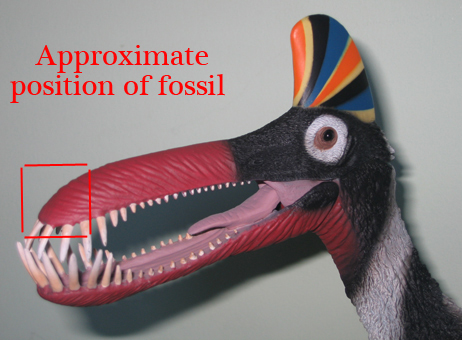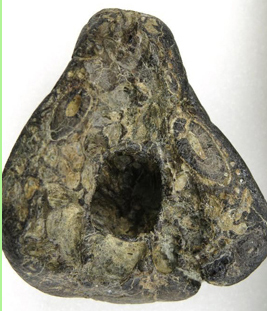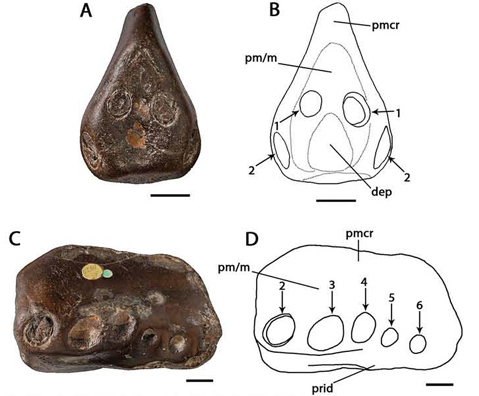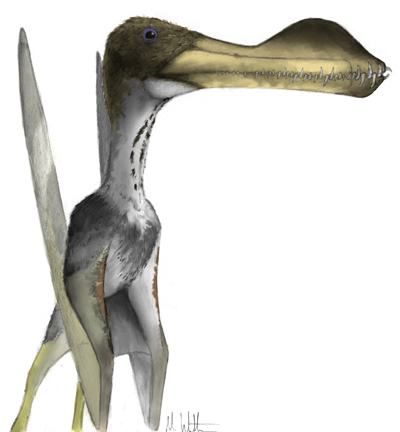Nosing Around a Remarkable Coloborhynchus Rostrum
Pterosaur Rostrum Discovered on the Isle of Wight
Thanks to sharp-eyed, local fossil collector Will Thurbin, a fragment of bone from an Early Cretaceous pterosaur has established that a another member of the Ornithocheiridae flew over the skies of what was to become the Isle of Wight. Whilst searching for fossils along Chilton Chine beach on the south-west coast of the Isle of Wight, Mr Thurbin spotted a strange looking, well worn pebble that when examined more closely showed traces of eroded teeth
Strange Fossil Discovery
Unsure of what the object was, he brought the specimen to the Dinosaur Isle museum on the island so that the experts there could examine it. After consulting Dr Dave Martill (School of Earth and Environmental Sciences at the University of Portsmouth), an expert in vertebrate fossils from the Isle of Wight, the find was identified as the tip of the rostrum the upper jaw of a Pterosaur genus known as Coloborhynchus.
To give readers an idea of which part of the animal the fossil belongs, we have taken the excellent model of Guidraco made by CollectA, another ornithocheirid, but this time from China and used this replica to show you where the rostrum is located.
Picture credit: Everything Dinosaur
CollectA Deluxe Pterosaur Figure
The picture (above), shows the rostrum of a CollectA Supreme/Deluxe pterosaur model. To view the CollectA Supreme/Deluxe range: CollectA Deluxe/Supreme Prehistoric Animal Figures.
Although very worn, the fossil still retained enough detail to provide the scientists with the opportunity to identify the family (Ornithocheiridae) and the pterosaur genus. The specimen, which is just a few centimetres long has gone on display at the Dinosaur Isle Museum.
The Isle of Wight Coloborhynchus Pterosaur Fossil
Picture credit: Isle of Wight Council
The fossil may not look much, but this fossil fragment, the tip from the upper jaw (rostrum), represents the world’s oldest example of the Coloborhynchus genus. It pre-dates earlier Coloborhynchus fossils by around ten million years. In all likelihood it is a new species, but that’s the trouble with the Pterosauria, lots of species have been named from just fragments of fossil material. This tends to “muddy the waters somewhat” when it comes to Pterosauria taxonomy, let’s look into this in a bit more detail.
The Problem with those “English Pterosaurs”
Coloborhynchus belongs to a very enigmatic family of pterosaurs, the Ornithocheiridae. The fossil record for the ornithocheirids is a bit of a “curates egg”, that is to say, that the fossil record is good in parts. Thanks to beautifully preserved specimens from China and South America, this family is amongst the best known of all the flying reptiles, but it has only been in the last twenty-five years or so that these specimens have come to light. Before that much of what we knew (or thought we knew) about these widespread Cretaceous pterosaurs came from the study of extremely fragmentary specimens found in southern England.
Poorly Preserved Specimens
These very poorly preserved fossils probably would not get a lot of attention these days, but back in the latter part of the 19th century these remains were studied by some of the most eminent scientists around at the time. The likes of Sir Richard Owen and Harry Govier Seeley examined and described these specimens, as a result, a range of different genera were erected, most of them now regarded as nomen dubium. Much of these fossil were excavated from the Cambridge Greensand of southern England, marine deposits laid down in the Cretaceous, with most of the material dating from around 105 to 115 million years ago.
Three-dimensional Fossil Material
The fossils are preserved in three-dimensions, just like the Isle of Wight Coloborhynchus specimen but they are the remains of pterosaurs that died far out to sea. The corpses were scavenged, the bones once they had sunk to the bottom of the sea became encrusted with shelled animals such as barnacles and they were drilled into by marine worms. These bones were eventually buried only to be exposed again by violent storms and finally buried as part of the fossil record several million years after the flying reptile had actually died. As a result, these fossils are extremely difficult to interpret, let alone assign to a new species.
Coloborhynchus clavirostris Holotype Fossil Material (Hastings Group)
Picture credit: Natural History Museum
The picture above shows one of the pterosaur fossils from the 19th century. This is the holotype for C. clavirostris, (A) = anterior view (view from the front), with (B) a line drawing of the same view. The fossil is viewed from the side, a left lateral view (C) with a corresponding line drawing (D). Numbers and arrows indicated teeth sockets (alveoli) and individual teeth.
Scale bar = 1cm.
Coloborhynchus Rostrum
When the Isle of Wight fossil is compared to the holotype fossil material (both seen in anterior view), these two specimens look very similar, but it was the position, orientation of the alveoli (teeth sockets) that aided identification.
The Isle of Wight Fossil Material with Teeth Sockets Labelled (anterior view)

Teeth sockets can clearly be seen, it was the orientation, shape and position of the teeth sockets that led to the Coloborhynchus identification.
Picture credit: Isle of Wight Council with additional annotation by Everything Dinosaur
Pterosaur Piscifores
It is very likely that these toothy pterosaurs were mainly fish-eaters and they lived on the coast, or at least in estuarine environments. The paper detailing this 2014 discovery has just been published in the Proceedings of the Geologists Association.
Intriguingly, in 2014, two fragmentary pieces of pterosaur rostrum were found on the Isle of Wight. They were found at different locations and they are shaped differently. The second fossil, donated by Mr Glyn Watson (Nottinghamshire), is currently being researched in order to identify the pterosaur family. This too, is likely to be a new species, although whether a species can be assigned from the rostrum alone has yet to be determined.
An Illustration of Coloborhynchus
Picture credit: Mark Witton
Coloborhynchus was certainly a sizeable pterosaur, although not the biggest member of the Ornithocheiridae. Size estimates are difficult to calculate based on fragmentary material, but a maximum wingspan between four and six metres has been cited by a number of authors.





